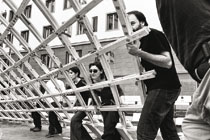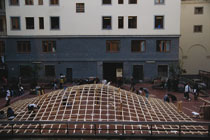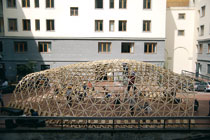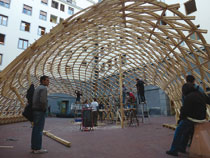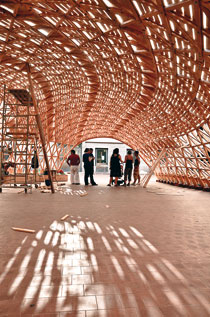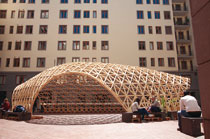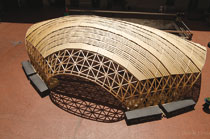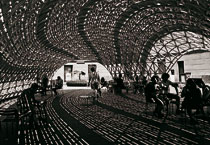The Toledo Gridshell. Sergio Pone

The Toledo Gridshell (Naples, School of Architecture Courtyard), represents a practice in which teaching and research worked out together in a constructive experimentation. It is also the first achievement that allowed to evaluate "in the field" the opportunity to furnish collective urban spaces in a flexible and reversible way by valorizing some specific inherent characteristics of "sustainability" trough the adoption of an innovative construction system such that of post-formed wooden shells.
Research on timber post-formed gridshells has been ongoing for about a decade due to the writer and his research team (composed of PhDs Sofia Colabella and Bianca Parenti, PhD student Bernardino D’Amico with the valuable support of prof. Eng. Raffaele Landolfo, prof. Eng. Francesco Portioli and PhD Eng. Mario D’Aniello, and prof. Arch. Alessandra Pagliano, Descriptive Geometry Researcher) and already produced some scientific achievements and a series of experimental artifacts.
As someone already knows, timber post-formed gridshells belong to the category of form-resistant structures, where the continuous shell surface and its double curvature are realized through the deformation of a regular grid made of small size wooden laths, disposed on orthogonal alternate planes. The main feature of timber gridshells consists in the uniqueness of the required (post-forming) construction process to realize them. The flat lattice is assembled on the floor (either on the ground - upward - or on a specially crafted higher level - downward) with the laths placed at given distance (0.5 x 0.5 m.), later deformed until the final shape is reached. This process causes two simultaneous phenomena which gradually modify the starting flat grid form: the first one corresponds to a local laths rotation (pantograph mechanism) with a subsequent conversion of the squares into a mesh of diamonds, while the second one results in bending deformation of the rods. The combination of these two mechanisms allows the grid, originally flat, to take the double curvature shape; a bit like pneumatic structures, that take their final shape only after the start-up of the air compressors. When the on-site forming process has completed and the gridshell takes the designed form, it's to proceed to the installation of the diagonal elements that increase the membrane stiffness.
In the work so far accomplished the research team decided to enhance the double vocation of timber gridshells: on one hand the eco-compatibility, on the other, the ease of construction and affordability. The structure, made with small section rods, is compatible with the production of coppice, with semi-finished products from Italian forests and in any case certified.
Natural eco-compatibility of this kind of structure is guaranteed avoiding the use of glued connection systems, and choosing natural surface treatments or water-soluble based impregnating agents, and so, by identifying dry and reversible assembled connections.
The reject to the help of the chemical industry products generated a series of technological complications but allowed to not compromise the “fully” sustainability of the entire process from construction to demolition (from cradle to grave).
A special version of the sustainability concept is what affected the used construction methods, which have always favored the labour intensive construction processes based on manpower rather than Computer-Aided-Manufacturing, against the capital intensive, trying to keep low building costs as relatively low is the cost of materials to be used. The cultural approach, borrowed from the philosophy of Makers and based on a very complex design intended to get an easier construction, generated a series of experiences in which designers-scholars didn't avoid the role of carpenters and were able to accumulate a practical knowledge experience, even sensory, which were extremely valuable for real understanding of the structure physical. Basically, a virtuous circle between the study of phenomena and their materialization in experimental structures was generated, including the construction and structural behavior expected and the effects on physical matter through the muscles strength and sense control.
This attitude made the gridshell experience especially suitable to the workshop formula in which students or recent graduates in architecture and engineering are involved in the artifacts design and construction. In all the experiences until now conducted, students found very formative approaching to a new and complex constructive typology, beginning to understand something and ending up actively participating in the prototype building. For a student, this is perhaps a way to shorten the paradoxical distance existing between himself and the buildings that can be admired on architectural magazines, between their little knowledge and the ever increasing complexity of a constructive process that frightens and repels.
The birth of Toledo gridshell is related to the occurrence of a unique positive circumstance: the group Forest s.r.l., cutting edge in wooden artifacts, led by PhD Eng. Agostino Presutti was available to sponsor an advanced constructive experimentation; the Faculty Council decided to realize a shaded area for students in one of the Faculty courtyards; Daniele Lancia e Andrea Fiore, deeply skilled in the use of complex parametric software, had the opportunity of joining the research team while doing their master thesis as a progress in the ongoing research: thorough a sophisticated form-finding method, their work aimed to confirm the validity of some assumptions made in the field of design and representation, sectors in which the complexity of the subject matter requires continuous refinement of the tools used for the correct design of gridshells.
The construction of the prototype in the Naples School of Architecture Courtyard had a wide appeal: the small team, originally composed by the research team and the new recruits, had grown day by day with the voluntary contribution of other students, teachers, and even the local residents and passers-by. The number of those who took part in asking about, giving suggestions advices, carrying tools or supplies, posting photos or comments on the social networks, writing articles, in the end came very close to the entire university community. The Toledo Gridshell, in practice, seems to have outlined an opportunity to materialize the chance to build in a new way the collective urban spaces, starting from a process in which sustainability takes shape thanks to the joint work of designers and users, private companies and public institutions. This is the main reason why this structure appears to have turned a space into a place that became the vibrant heart of a community, self-re-discovered as such in the two weeks of work, that probably has no desire to return to past indifference.
